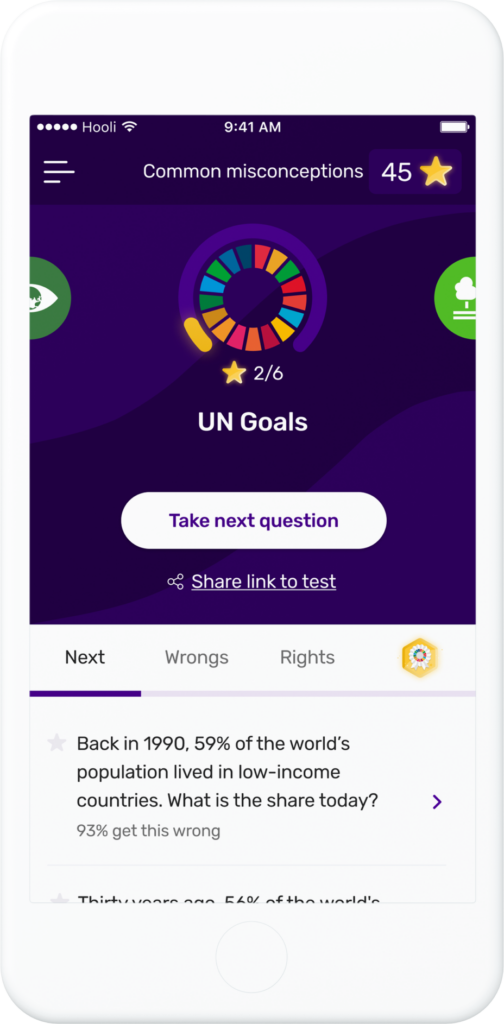PRESS RELEASE 30 NOVEMBER 2020
Today, Gapminder launches a new free educational service called the Worldview Upgrader, which will help people and organizations realize their ignorance and rid themselves of common misconceptions.
For many years, Gapminder has tested the public knowledge and identified systematic misconceptions about global trends and proportions and invented different tools to fight these misconceptions. Today, we are releasing this groundbreaking new online service in which users can test themselves and replace misconceptions with updated facts.
The format is simple: ABC questions about global trends and proportions. All questions have been carefully selected based on the strict criteria that most people answer them wrongly. As we disclosed in our latest study (the Sustainable Development Misconceptions Study 2020), these fact questions capture widespread misconceptions about global trends and proportions that most people suffer from. The sum of which adds up to a completely wrong worldview. With this new service, users can test their preconceived ideas about important global trends that almost everyone is wrong about. If they learn the facts and answer the questions correctly, they can get a certificate that proves they have upgraded their worldview. The initial test contains global questions across all the subjects of the UN’s Sustainable Development Goals (SDGs).

Gapminder’s goal is to make it easier for people to quickly rid themselves of misconceptions. As the world keeps changing, the facts change, and the questions will be updated and new ones will be added. The Worldview Upgrader will provide a simple way to upgrade people’s worldview.
Ola Rosling, co-founder of Gapminder, said:
“Together with my father Hans Rosling, I gave a TED-talk in 2014 (“How not to be ignorant about the world”) where I described my vision to capture and dismantle systematic misconceptions. After years of hard work, today it becomes reality and I am super excited about this!
“Many people rely on the media to understand the world, but it mostly focuses on exceptional and temporary events and, because of that, it can’t be expected to give people a good picture of big proportions and the slow changing trends. But in a globalized world, everyone needs a worldview that is based on data, and it needs to keep upgrading as the world changes. The staff in companies, schools and other organizations are currently wrong about the state of the world, often because they have facts that were true more than forty years ago. The Worldview Upgrader helps people and organizations quickly rid themselves of the most common misconceptions. Fortunately, the misconceptions are systematic, so we realized we could build a systematic solution to the problem. I’m convinced this will lead to better decisions for positive change, and I know my father would have loved it.”
In the first version launched today, there’s one global test with one question for each of the UN Goals. Over the next couple of months we will roll out hundreds of new test questions about all aspects of global development that most people are wrong about.

The service is free to use. All you need is an internet connection. We hope that journalists, teachers and students, politicians, business leaders and staff, will test themselves and realize what they are wrong about.
In the coming months, we will also announce our plans to help educate organizations to use the service and get certificates that prove their staff have an upgraded worldview.
About Gapminder
Gapminder was founded by Ola Rosling, Anna Rosling Rönnlund and Hans Rosling in 2005. It is an independent educational non-profit specialized in global misconceptions. It aims to fight common misconceptions with a fact-based worldview that everyone can understand.
About the Worldview Upgrader
The Worldview Upgrader is a service that helps people and organizations quickly rid themselves of the most common misconceptions and replace them with updated facts. You can test yourself or your team and get certified at upgrader.gapminder.org

If you would like to schedule an interview with Anna Rosling Rönnlund and Ola Rosling or have inquiries regarding the new service, please contact:
Klara Elzvik, Media Relations Coordinator
+46 70 229 9983


